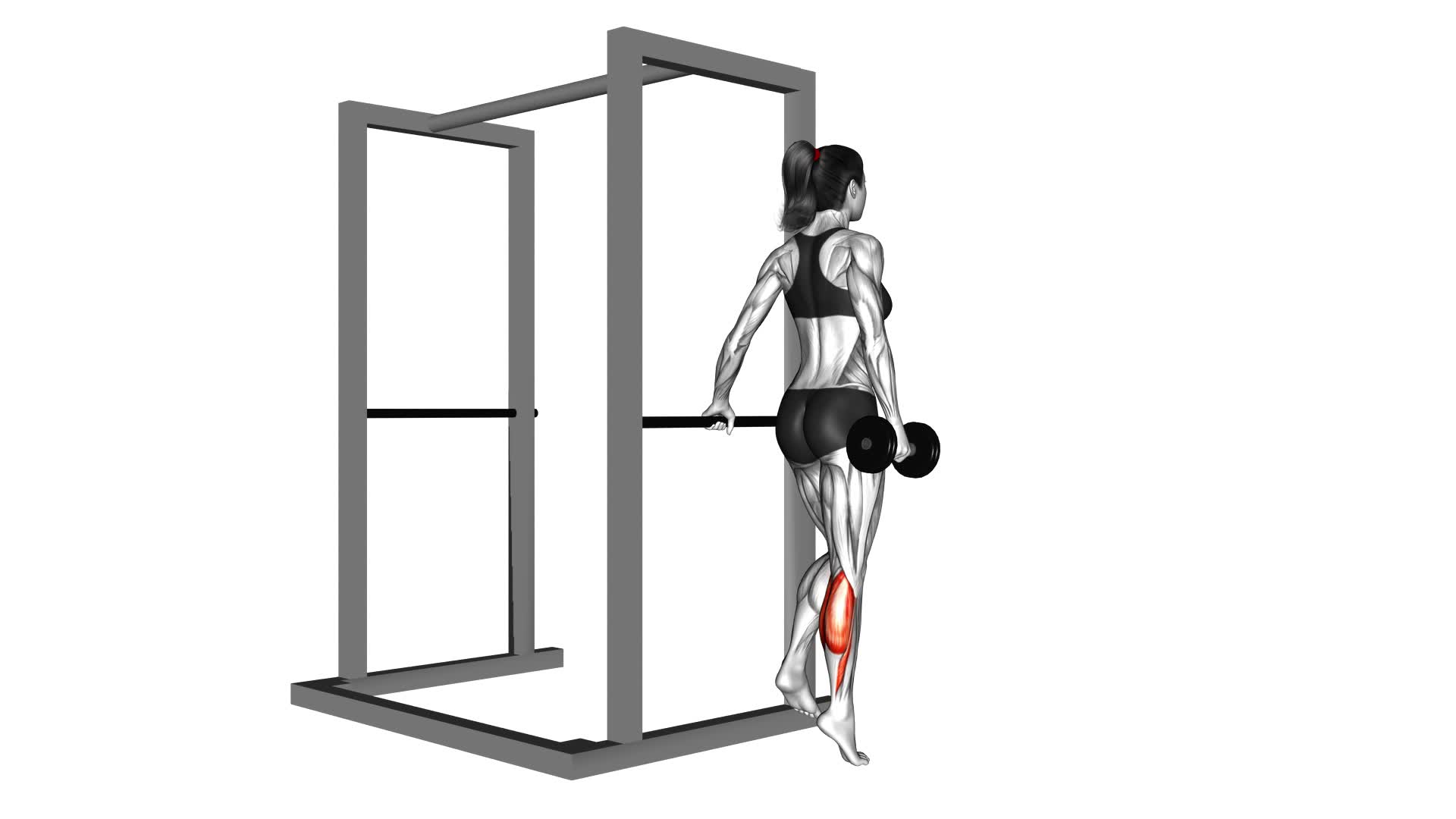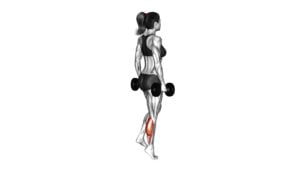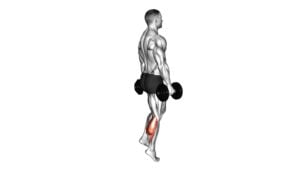Dumbbell Single Leg Calf Raise (female) (VERSION 2) – Video Exercise Guide & Tips

Get ready to tone and strengthen your calves with the Dumbbell Single Leg Calf Raise (female) (VERSION 2).
Watch This Exercise Video
This exercise guide and video will show you the proper form and technique, as well as modifications and progressions to challenge yourself. Avoid common mistakes and reap the benefits of this targeted workout.
Grab your dumbbells and get ready to feel the burn in your calves.
Let's go!
Key Takeaways
- Dumbbell Single Leg Calf Raise on an elevated surface increases range of motion
- Unilateral movement improves balance, stability, and identifies muscle imbalances
- Dumbbell adds resistance for muscle growth and better results
- Targets calf muscles effectively for strengthening and toning
Equipment Needed for the Exercise
To perform the Dumbbell Single Leg Calf Raise exercise, you'll need a dumbbell. However, if you don't have access to one, there are bodyweight alternatives that you can try. This exercise primarily targets the calf muscles and helps to improve their strength and definition.
If you don't have a dumbbell, you can perform this exercise using just your bodyweight. Simply stand with your feet hip-width apart and lift one leg off the ground, balancing on the other leg. Then, rise up onto the ball of your foot while keeping your balance. Slowly lower your heel back down to the ground and repeat on the other leg.
For those looking for advanced variations, you can try using a weighted vest or ankle weights to increase the resistance. This will make the exercise more challenging and help to further strengthen your calf muscles.
Additionally, you can also try performing the exercise on an elevated surface, such as a step or box. This will increase the range of motion and provide a greater challenge to your calf muscles.
Remember to start with a weight or variation that's appropriate for your fitness level and gradually increase as you get stronger.
Proper Form and Technique
Use a proper form and technique when performing the Dumbbell Single Leg Calf Raise exercise to ensure optimal results and prevent injury. Here are some key tips to keep in mind:
- Stand tall with your feet hip-width apart, holding a dumbbell in one hand.
- Shift your weight onto one leg and lift the opposite foot slightly off the ground.
- Slowly raise your heel as high as possible, feeling a stretch in your calf muscle.
- Hold the raised position for a brief moment, then lower your heel back to the starting position.
By following these guidelines, you can improve your balance and increase calf strength effectively. Maintaining proper form and technique is crucial to avoid strain or injury. Remember to engage your core muscles and keep your body stable throughout the movement. It's also important to start with a weight that challenges you but allows for proper execution.
In the next section, we'll discuss modifications and progressions to help you further enhance your calf strength and balance. By gradually increasing the weight or performing the exercise on an unstable surface, you can continue to challenge your muscles and see continued improvements in your fitness journey.
Modifications and Progressions
To further enhance your calf strength and balance, you can make modifications and progressions to the Dumbbell Single Leg Calf Raise exercise. By incorporating variations into your routine, you can challenge your muscles in different ways and continue to make progress.
One progression you can try is the Dumbbell Single Leg Calf Raise on an elevated surface. Find a step or a sturdy platform and place the ball of your foot on the edge, with your heel hanging off. Hold onto a wall or a stable object for support, and then perform the exercise as usual. This variation increases the range of motion and puts more emphasis on your calf muscles.
Another progression is to increase the weight of the dumbbell. Start with a lighter weight and gradually work your way up to a heavier one. This will provide more resistance and help to build even more strength in your calf muscles.
If you're looking for a modification that requires less equipment, you can try the bodyweight Single Leg Calf Raise. Simply perform the exercise without any added weight, focusing on maintaining proper form and control throughout the movement.
Remember to listen to your body and progress at a pace that feels challenging but not overwhelming. By incorporating these progressions and variations into your routine, you can continue to improve your calf strength and balance over time.
Common Mistakes to Avoid
You should be mindful of common mistakes to avoid when performing the Dumbbell Single Leg Calf Raise exercise. To ensure optimal results and prevent injury, take note of the following variations that are often done incorrectly:
- Lifting too quickly: Resist the urge to rush through the movement. Slow, controlled lifts will engage the calf muscles more effectively.
- Neglecting proper alignment: Keep your body in a straight line, with your shoulders back and core engaged. Avoid leaning forward or arching your back.
- Not fully extending: Make sure to fully extend your ankle and raise your heel as high as possible, maximizing the contraction of the calf muscles.
- Using excessive weight: While it may be tempting to go heavy, using too much weight can compromise your form and increase the risk of injury. Start with lighter weights and gradually increase as your strength improves.
By avoiding these common mistakes, you can perform the Dumbbell Single Leg Calf Raise exercise safely and effectively.
Now let's move on to the next section and explore the benefits of this exercise.
Benefits of the Dumbbell Single Leg Calf Raise (female) (VERSION 2)
To continue building on the benefits of the Dumbbell Single Leg Calf Raise (female) (VERSION 2) exercise, let's explore how it can strengthen and tone your calf muscles effectively. This version of the exercise, which specifically targets the calf muscles of women, offers several advantages.
Firstly, the Dumbbell Single Leg Calf Raise (female) (VERSION 2) allows for a greater range of motion compared to traditional calf raises. By elevating your heel on a step or platform and holding a dumbbell in one hand, you increase the stretch and contraction in your calf muscles. This increased range of motion helps to engage more muscle fibers, leading to greater muscle activation and ultimately, better results.
Secondly, this exercise is a unilateral movement, meaning it works one leg at a time. This is particularly beneficial for improving balance and stability, as it requires greater core and ankle strength to maintain proper form. By targeting each leg individually, you can also identify and correct any muscle imbalances or weaknesses, which can help reduce the risk of injuries.
Lastly, the inclusion of a dumbbell adds resistance to the exercise, making it more challenging and effective for muscle growth. By progressively increasing the weight of the dumbbell over time, you can continue to challenge your calf muscles and promote further strength gains.
Frequently Asked Questions
How Many Repetitions Should I Do for the Dumbbell Single Leg Calf Raise (Female) (Version 2)?
For the dumbbell single leg calf raise (female) (version 2), it's important to focus on quality rather than quantity. Start with a weight that challenges you, but allows you to maintain proper form. Aim for 8-12 repetitions on each leg, ensuring a full range of motion.
As you progress, increase the weight or try performing the exercise on an elevated surface for added difficulty. Incorporating single leg exercises into your routine can improve balance, stability, and target specific muscle groups.
Can I Perform This Exercise Without Using Dumbbells?
Yes, you can perform the single leg calf raise exercise without using dumbbells.
If you don't have access to dumbbells, there are modifications you can do. You can try using your body weight by standing on one leg and raising your heel as high as possible, then lowering it back down.
Another option is to hold onto a sturdy object, like a wall or chair, for balance while performing the exercise.
Remember to focus on engaging your calf muscles throughout the movement.
Is It Better to Perform This Exercise Barefoot or With Shoes On?
When it comes to the dumbbell single leg calf raise, you might be wondering whether it's better to go barefoot or wear shoes.
The choice is yours, but both options have their benefits. Going barefoot allows for better balance and stability, while wearing shoes can provide additional support and cushioning.
As for using dumbbells in this exercise, they help to increase the intensity and challenge your calf muscles even more.
Can I Do This Exercise if I Have a Previous Calf Injury?
If you have a previous calf injury, it's important to be cautious when doing this exercise. Before attempting it, consult with a medical professional to ensure it won't aggravate your injury.
They may recommend modifications for calf exercises that are more suitable for your condition. Remember to listen to your body and stop if you experience any pain or discomfort.
Take care of your calf and prioritize your recovery.
How Often Should I Incorporate the Dumbbell Single Leg Calf Raise (Female) (Version 2) Into My Workout Routine?
To progress in the dumbbell single leg calf raise (female) (version 2), incorporate it into your workout routine 2-3 times a week.
Start with lighter weights and gradually increase the resistance as you get stronger.
Avoid common mistakes like using momentum or not fully extending your ankle at the top of the movement.
Consistency and proper form are key to seeing results and preventing injury.
Conclusion
In conclusion, the dumbbell single leg calf raise (female) (version 2) is a great exercise for strengthening and toning the calf muscles.
It requires minimal equipment and can be easily modified or progressed to suit different fitness levels.
By performing this exercise with proper form and technique, you can avoid common mistakes and maximize the benefits.
Incorporating this exercise into your routine can help improve balance, stability, and overall lower body strength.

Author
Years ago, the spark of my life’s passion ignited in my mind the moment I stepped into the local gym for the first time. The inaugural bead of perspiration, the initial endeavor, the very first surge of endorphins, and a sense of pride that washed over me post-workout marked the beginning of my deep-seated interest in strength sports, fitness, and sports nutrition. This very curiosity blossomed rapidly into a profound fascination, propelling me to earn a Master’s degree in Physical Education from the Academy of Physical Education in Krakow, followed by a Sports Manager diploma from the Jagiellonian University. My journey of growth led me to gain more specialized qualifications, such as being a certified personal trainer with a focus on sports dietetics, a lifeguard, and an instructor for wellness and corrective gymnastics. Theoretical knowledge paired seamlessly with practical experience, reinforcing my belief that the transformation of individuals under my guidance was also a reflection of my personal growth. This belief holds true even today. Each day, I strive to push the boundaries and explore new realms. These realms gently elevate me to greater heights. The unique combination of passion for my field and the continuous quest for growth fuels my drive to break new ground.







